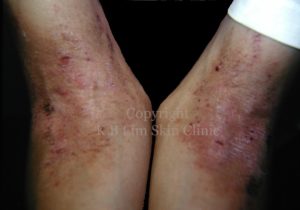Learn about Atopic Dermatitis and tips on how you can help yourself below or watch the video below:
Atopic dermatitis is a type of eczema occurring in people with an atopic tendency which means a tendency to develop any or all three atopic conditions, namely atopic dermatitis, asthma and hay fever (allergic rhinitis). Atopic dermatitis is more common in children but can affect adults as well. It affects 10% and 20% of children and about 1% to 3% of adults. It is a long-lasting skin disease that flares up periodically.
Causes
- Atopic dermatitis occcurs because of a complex interaction between genetic and enviromental factors. 80% of patients have one or more relatives affected.
- Impaired skin barrier function making the skin susceptible to irritation by soap and other contact irritants, the weather, temperature and non-specific triggers. An alteration in a gene that is important in maintaining a healthy skin barrier has been closely linked to the development of eczema. This makes the skin of patients with eczema much more susceptible to infection and allows irritating substances/particles to enter the skin, causing itching and inflammation. Non infectious and cannot be spread to others.
Symptoms
- Eczema appears as red itchy bumps or dry, scaly patches.
- In acute cases, these may ooze clear fluid or become crusty.
- In chronic cases, the patches become darkened and lichenified (leathery thickened and darkened skin) through constant scratching or rubbing.
- In infants and very young children, atopic dermatitis usually affects the face, scalp, napkin areas and limbs.
- In toddlers, it affects the outer aspects of joints, particularly the wrists, elbows, ankles and knees (commonly called the extensor pattern) and occasionally, also the genitals.
- In older children and adults, it usually affects the fold areas in the neck, front of the elbows and back of the knees (commonly called the flexural pattern).

Itch is usually severe and there are often scratch marks and even bleeding points. Scratching make the dermatitis worse so an itch-scratch-rash cycle develops, causing the dermatitis to flare suddenly. Acute flares are common during which chronic eczema takes on the appearance of acute eczema with oozing, blistering and crusting.
Learn About the Triggers that can make Atopic Dermatitis spiral out of control
- Heat, dust, woollen and roughly textured fabrics, pets and irritants such as soaps, detergents and other chemicals.
- Bacterial and viral infections.
- Dryness of the skin.
- Food allergens may cause a flare up. Culprits include milk, nuts, and shellfish. Allergy tests can determine the cause.
- Stress
- Over-colonisation by the staphylococcal bacteria can stimulate the immune system and aggravate the eczema.
Outlook
Childhood eczema generally improves with age.
- 60% clear by their teens.
- Some continue into adult life as localised eczema in any one or more of the following areas – hands, eyelids, flexures, lips and nipples.
Complications
- Bacterial infection, especially staphylococcal infections are common and may recur frequently due to scratching.
- Herpes simplex virus infection (“cold sores”) leading to a generalised herpes infection known as eczema herpeticum.
- Increased susceptibility to warts and molluscum contagiosum.
Self-help tips
- Reduce exposure to known triggers.
- Avoid woollens and roughly textured fabrics which trigger itching.
- Avoid scratching so you don’t perpetuate the itch-scratch-rash cycle that makes eczema worse.
- Cut finger nails short so as to reduce skin trauma and infection.
- Manage stress.
- Avoid heat and excessive sweating.
- Moisturise the skin frequently, especially after a shower or bath.
- Apply medication regularly (compliance is very important even though it requires regular application of sticky creams and ointments.
Severity of Atopic Dermatitis can be assessed with the following clinical tools:
- EASI (Eczema Area and Severity Index) for patients aged 8 years and above – for professional use
- EASI (Eczema Area and Severity Index) calculator for patients under 8 years of age – for professional use
- SCORAD (SCORing Atopic Dermatitis) – for professional use
- POEM (Patient Oriented Eczema Measure) is a simple tool developed by the University of Nottingham for patients to assess the severity of their eczema (Atopic Dermatitis)
Treatment
There are many treatments that can help eczema but the patients must also do their part.
- Oral antihistamines to relieve itching and break the itch-scratch-rash cycle.
- Topical steroids and non-steroidal topical medication such as the calcineurin inhibitors pimecrolimus cream and tacrolimus ointment and crisaborole. Crisaborole works by inhibiting PDE-4 (phosphodiesterase-4) enzyme which is overactive in atopic dermatitis.
- More severe and extensive cases may require oral steroids and immunosuppressive drugs including ciclosporin, azathioprine, methotrexate and mycophennlate or NBUVB (narrow-band UVB) Crisaborole ointment, a new non-steroidal topical therapy that inhibits the PDE-4 (phosphodieterase-4) enzyme in the skin is available in some countries. Overactive PDE-4 has been shown to contribute to the signs and symptoms of atopic dermatitis. Dupilumab, an injectable biologic agent, is now available for the treatment of adults with moderate to severe atopic dermatitis.
- Topical steroids and wet wrap treatment with tubular dressing is also effective but require hospitalisation. The change in environment and away from stress may also contribute to the improvement.
- Antibiotics for secondary bacterial infection.
Skin prick tests and IgE RAST on blood may be necessary to exclude food allergies in selected cases.